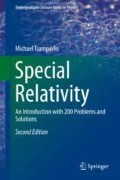Abstract
Abstract
Access this chapter
Tax calculation will be finalised at checkout
Purchases are for personal use only
Notes
- 1.
“The stone age did not finish because they run out of stones; but because it was found the iron which was a better solution to the stone.”
- 2.
An English translation of this paper can be found in the book Principle of Relativity by H. Lorentz, A. Einstein, H. Minkowski, H. Weyl, Dover (1952). In this volume one can find more papers which lead to the development of the Theory of Special Relativity including the work of Einstein where the famous relation E = mc 2 appeared for the first time as well as the introduction of the term spacetime by H. Minkowski.
- 3.
Also it has to do with the linearity of the space.
- 4.
A relativistic mass point should be understood as a particle with non-zero proper mass and speed < c. In Sect. 6.2 we shall give a geometric and precise definition of the relativistic mass point.
- 5.
This does not mean that different observers attribute the same coordinates to a given event. But there is a coordinate transformation which brings the coordinates of one observer to the values of the coordinates of the other observer and vice versa.
- 6.
Recall that a LCF (Relativistic Cartesian Frame) is a coordinate system in which the Lorentz metric has its canonical form diag(−1, 1, 1, 1).
- 7.
It is instructive to mention at this point that Newtonian Physics can be formulated in a four dimensional Euclidian space, where one dimension is for the time and three dimensions are for the Euclidian space E 3 in the same way it is done in Minkowski space. This four-dimensional space is foliated by the hyperplanes E 3, however due to the absolute nature of time, this foliation is the same for all Newtonian Inertial Observers. The different foliations of Special Relativity and the unique foliation of Newtonian Physics is the fundamental difference (apart from the character of the metric) between the two theories.
- 8.
We write cτ instead of τ for the time component, because the components of a vector must have the same dimensions, that is space length [L]1[T]0[M]0.
- 9.
Note that the four-vector AB i is defined by the events: A: The light beam passes the point A and B: The light beam passes the point B. The four vector AB i is a null vector.
- 10.
However the form diag(−1, 1, 1, 1) changes if frames different than LCF are used.
- 11.
In the literature one can find many derivations of the proper Lorentz transformation – mainly of the boosts – using a more or less axiomatic approach. Some of them are:
-
1.
D. Sardelis “Unified Derivation of the Galileo and the Lorentz transformation” Eur. J. Phys. (1982) 3, 96–99
-
2.
A.R. Lee and T.Malotas “Lorentz Transformations from first Principles” Am. J. Phys. (1975) 43, 434–437 and Am. J. Phys. (1976)44, 1000–1002
-
3.
V.Berzi and V. Gorini “Reciprocity Principle and the Lorentz Transformation” (1968) J. Math. Phys. 10,1518–1524
-
4.
C. Fahnline “A covariant four-dimensional expression for Lorentz transformations” Am. J. Phys. (1982) 50, 818–821.
-
1.
- 12.
Universal is a scalar physical quantity which has the same value in all (and the accelerated!) coordinate systems of the theory.
Author information
Authors and Affiliations
Rights and permissions
Copyright information
© 2019 Springer Nature Switzerland AG
About this chapter
Cite this chapter
Tsamparlis, M. (2019). The Foundation of Special Relativity. In: Special Relativity. Undergraduate Lecture Notes in Physics. Springer, Cham. https://doi.org/10.1007/978-3-030-27347-7_4
Download citation
DOI: https://doi.org/10.1007/978-3-030-27347-7_4
Published:
Publisher Name: Springer, Cham
Print ISBN: 978-3-030-27346-0
Online ISBN: 978-3-030-27347-7
eBook Packages: Physics and AstronomyPhysics and Astronomy (R0)

